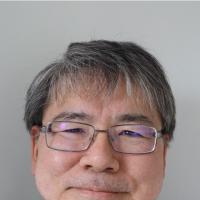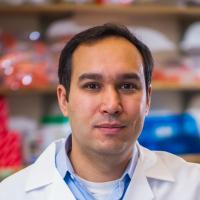Projects
Transformed Esophageal Epithelial Cells and the Tumor Microenvironment
Hiroshi Nakagawa, MD, PhD
- Columbia University Herbert Irving Comprehensive Cancer Center

Project Description
Esophageal cancers comprise two major subtypes: esophageal squamous cell carcinoma (ESCC) and esophageal adenocarcinoma (EAC). Herein, we focus upon the pathogenesis and translational therapeutics of ESCC and draw comparisons to EAC when possible. ESCC is the deadliest of all human squamous cell carcinomas. Its common genetic lesions include the p53 tumor suppressor and epidermal growth factor receptor (EGFR) as revealed in Project 3. Mutant p53 impairs cell-cycle arrest or apoptosis in response to cellular stress. EGFR activates mitogen-activated protein kinase (MAPK). Additionally, EGFR and mutant p53 facilitate epithelial-mesenchymal transition (EMT). EMT fosters intra-tumoral heterogeneity and tumor stroma remodeling in ESCC. The malignant properties of ESCC may stem from a subset of cells characterized by high CD44 expression (=CD44H) that in turn promote tumor invasion in the stroma, tumor metastasis (e.g. lung) and conventional therapeutic resistance.
The overall objective in Project 1 is to elucidate the molecular mechanisms by which mutant p53 and the tumor microenvironmental cues cooperate to drive ESCC invasion and metastasis, and as a result, unravel new therapeutic targets in synergy with Projects 2 and 3. Utilizing cell lineage-traceable mice treated with the esophageal carcinogen 4-nitroquinoline 1-oxide (4NQO), three- dimensional (3D) culture systems that recapitulate human pathology, and patient-derived xenograft (PDX) tumors with clinically available pharmacological inhibitors, our published and unpublished preliminary data indicate that the interplay between ESCC cells (harboring mutant p53) and cancer-associated fibroblasts (CAFs) and ESCC cells triggers EMT to induce CD44H cells. CD44H cells produce cytokines RANTES and interleukin (IL)-6 to drive ESCC invasion. CD44H cells also display downregulation of the Rab GTPase- coupling protein (RCP)-mediated endocytosis recycling pathway to stabilize cell surface proteins, including EGFR and the RANTES receptor CCR5. Moreover, mutant p53 (p53R172H) facilitates ESCC EMT and lung metastasis.
Our central hypothesis is that mutant p53 and CAFs foster the emergence of CD44H ESCC cells with increased malignant properties and possible metastasis. We will test our hypothesis by pursuing the following interrelated Specific Aims: (1) To elucidate the role of RANTES as a mediator of the crosstalk between ESCC cells and CAFs; (2) To delineate how mutant p53 facilitates metastasis via CD44H cells; and (3) To determine how mutant p53 impacts upon the endocytic recycling pathway in ESCC invasion. We work closely with projects 2 and 3, with support from the core facilities, to translate our findings into new therapeutics that disable the protumorigenic ESCC microenvironment and subsequent proclivity for metastasis.
Protein Ubiquitylation in Esophageal Cancer
J. Alan Diehl, PhD
- Case Western Comprehensive Cancer Center

Project Description
Cyclin D1 deregulation is observed frequently observed in human cancers especially in esophageal squamous cell carcinoma (ESCC) and esophageal adenocarcinomas (EAC). This deregulation implies that the cyclin D1/CDK4 kinase provides cells with a growth advantage, thereby contributing to cancer development. We have demonstrated that loss of Fbxo4, a component of the E3 ligase, SCFFBXO4, occurs in ESCC and FBXO4 knockout mice are susceptible to tumors. Additional work has revealed that FBXO4 regulates degradation of two distinct oncogenes in ESCC: cyclin D1 and FXR1. Overexpression of cyclin D1 increases mitogen- independent cell proliferation and FXR1 overexpression contributes to bypass of cell senescence and collective tumor initiation. In our new preliminary data, we have discovered that loss of FBXO4 results in cell addiction to Glutamine. In this context, glutamine appears essential due to its metabolic role, wherein it is metabolized to α-ketoglutarate, an intermediate in the TCA cycle. Cells with mutant FBXO4 quickly undergo apoptosis under conditions of glutamine restriction. Given the generation of inhibitors of glutaminase, this observation provides a potential novel strategy for therapeutic intervention.
These exciting discoveries provide critical insights into the mechanisms whereby FBXO4 suppresses neoplastic growth and support the notion that targets of FBXO4 such as FXR1 and cyclin D1/CDK4 activity are key esophageal cancer drivers. The identification of the SCFFBX4 as the cyclin D1 E3 ligase as well as our preliminary studies lead to the overarching hypothesis that the SCFFBX4 E3 ligase maintains threshold levels of the cyclin D1/CDK4 kinase and the FXR1, an RNA binding protein, to maintain esophageal tissue homeostasis. We hypothesize further that cyclin D1 and FXR1 overexpression foster ESCC progression, resulting in cellular vulnerabilities that can be rationally targeted. This hypothesis will be pursued through the following interrelated Specific Aims: (1) To determine the contribution of deregulated cyclin D1 to mutant FBXO4 driven glutamine-dependence in esophageal cancer; (2) To determine the mechanism(s) whereby mutant p53R172H cooperates with cyclin D1T286A to drive ESCC pathogenesis; and (3) To determine the therapeutic potential of targeting glutamine- metabolism in ESCC with dysregulated cyclin D/CDK4. Our collaborative work with Projects 1 and 2, along with support from the Core Facilities, provides new basic and translational perspectives on the cyclin D1/CDK4/CDK6 axis and glutamine metabolism in ESCC.
Genome-Guided Therapeutic Vulnerabilities in Esophageal Cancer
Kwok-Kin Wong, MD, PhD
- New York University Langone Perlmutter Cancer Center

Project Description
New therapies are desperately needed for esophageal cancer, which is responsible for >400,000 deaths annually. Herein we propose to build on momentum from our prior studies, founded on our observation that the most prominent genomic targets in esophageal cancer, both squamous cell carcinoma (ESSC) and adenocarcinoma (EAC), are amplifications of genes encoding mediators of the cell cycle such as CCND1=Cyclin D1 (collaboration with Project 3) and CCNE1=Cyclin E1 and genes encoding receptor tyrosine kinases such as EGFR (collaboration with Project 1) and ERBB2. Given this genomic landscape, a key premise of our work has been that developing therapeutic approaches that integrate targeting of both active kinases and cell cycle dysregulation will be remarkably beneficial.
While these data, hypotheses and premises all continue to hold true, we now propose a more nuanced assessment of how cell cycle dysregulation may impact tumorigenesis and optimal cancer therapy. Specifically, we hypothesize that amplification and overexpression of Cyclin D1 and Cyclin E1 can have effects upon the tumor microenvironment and upon genomic stability, both of which have clear implications for optimal therapy. This hypothesis will be pursued through the following interrelated specific aims: (1) To determine how CDK4/6 inhibitors impact the tumor microenvironment in CCND1-amplified esophageal squamous cell carcinoma and to define enhanced immune therapy strategies; and (2) To elucidate how CCNE1 amplification promotes chromosomal instability, kinase amplification and immune evasion in esophageal adenocarcinoma. Together, these studies will help us develop rationale, biomarker-guided therapies for these deadly cancers. This work will be done in close collaboration with projects 1 and 2 to drive presentations, publications and transform the clinical landscape of esophageal cancer, and to utilize the core facilities in an integrated fashion with the other projects.



